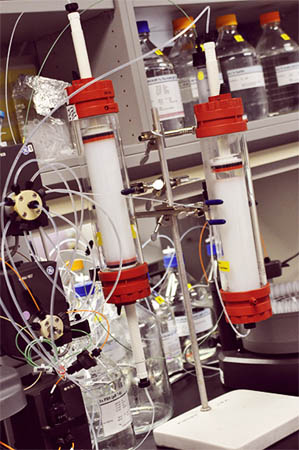ARC™ Technology
 Pure Transplant Solutions has developed a proprietary immunotherapeutic protein suitable for integration into a combination medical device for use in a novel, selective antibody removal therapy. This immunotherapeutic device is called the ARC™ or selective HLA Antibody Removal Column™. Antibody removal is accomplished using a dialysis-like process, called plasmapheresis, capable of removing anti-HLA antibodies (Abs) prior to transplantation, allowing a waiting recipient to receive an otherwise non-permissible, or antibody-incompatible organ.
Pure Transplant Solutions has developed a proprietary immunotherapeutic protein suitable for integration into a combination medical device for use in a novel, selective antibody removal therapy. This immunotherapeutic device is called the ARC™ or selective HLA Antibody Removal Column™. Antibody removal is accomplished using a dialysis-like process, called plasmapheresis, capable of removing anti-HLA antibodies (Abs) prior to transplantation, allowing a waiting recipient to receive an otherwise non-permissible, or antibody-incompatible organ.
Previous methods to remove HLA Abs have been totally lacking in their specificity, leading to the broad removal of all serum immunoglobulins, other serum proteins including clotting factors, or a combination of both. This lack of specificity creates a myriad of adverse effects in patients increased risk of unstoppable bleeding, infection, cancer, diabetes, hypertension, and systemic atherosclerosis requiring further drug treatments and immunoglobulin replacement.
PTS is able to produce the quality, quantity and wide variety of HLA proteins necessary to address these specificity issues in direct clinical use and has the required technical capabilities to achieve this important advance in transplant medicine.
Selective antibody removal therapy will serve to augment standard anti-rejection drug therapies yielding an even greater success at extending the functional life of a transplanted organ. Removing only the antibodies that target the HLA of the transplanted organ will likely allow for more effective use of post-transplant immunosuppressant drugs and help to limit the negative side-effects associated with heavy use. This has the major benefit of reducing the patient’s vulnerability to subsequent infections that often result from long-term anti-rejection drug therapy.
The ARC HLA-protein column, offers a number of important clinical advantages for solid organ transplantation.
• Specificity: targets and removes only the problematic HLA Abs. Beneficial Abs, such as virus-specific and anti-idiotype Abs are not removed.
• Tolerability: does not remove proteins required for normal coagulation and cardiovascular stability.
• Effectiveness: removes a large proportion of plasma HLA Abs in one session. With good tolerability, prolonged and repeat treat ment sessions are possible. This allows treatment of highly sensitized patients, including those experiencing HLA Ab
mediated rejection post-transplant.
• Safety: leaves the humoral immune system intact while removing problematic HLA Abs. The risk of infection will not increase because antibacterial, antifungal and antiviral Abs will not be removed.
ARC™ benefits

- Increases long-term survival rates by decreasing the frequency of organ rejection episodes
- Significantly expands the donor organ pool by diminishing the need for re-transplantations
- Reduces overall costs of organ transplantation by limiting complications and by increasing immunosuppressive drugs efficacy
- Allows organ transplantation to be a viable option to those who have been unable to find a donor match based on their “highly sensitized” condition
- Improved quality of life post-transplant by enhancing the effectiveness of traditional long-term anti-rejection therapy without creating secondary health conditions
Patient and Provider Benefits

- • Better patient care
- • More transplantation surgeries by:
- • making a living donor, HLA antibody-incompatible transplant easier and safer,
- • performing living donor transplants currently prohibited in highly sensitized patients because of their antibody levels,
- • extending transplantation into areas currently not feasible, such as deceased donor transplants across antibody barriers, and
- • investigating the role of selective antibody removal in chronic antibody-mediated rejection to prolong the life of the donor organ after transplantation
- • Lower medical insurance impact from long-term care of wait-listed patients
- • Improved quality of life post-transplant by enhancing the effectiveness of traditional long-term anti-rejection therapy without creating secondary health conditions.
